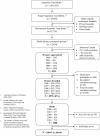Environments For Healthy Living (EFHL) Griffith birth cohort study: characteristics of sample and profile of antenatal exposures
- PMID: 23241307
- PMCID: PMC3558353
- DOI: 10.1186/1471-2458-12-1080
Environments For Healthy Living (EFHL) Griffith birth cohort study: characteristics of sample and profile of antenatal exposures
Abstract
Background: The Environments for Healthy Living (EFHL) study is a repeated sample, longitudinal birth cohort in South East Queensland, Australia. We describe the sample characteristics and profile of maternal, household, and antenatal exposures. Variation and data stability over recruitment years were examined.
Methods: Four months each year from 2006, pregnant women were recruited to EFHL at routine antenatal visits on or after 24 weeks gestation, from three public maternity hospitals. Participating mothers completed a baseline questionnaire on individual, familial, social and community exposure factors. Perinatal data were extracted from hospital birth records. Descriptive statistics and measures of association were calculated comparing the EFHL birth sample with regional and national reference populations. Data stability of antenatal exposure factors was assessed across five recruitment years (2006-2010 inclusive) using the Gamma statistic for ordinal data and chi-squared for nominal data.
Results: Across five recruitment years 2,879 pregnant women were recruited which resulted in 2904 live births with 29 sets of twins. EFHL has a lower representation of early gestational babies, fewer still births and a lower percentage of low birth weight babies, when compared to regional data. The majority of women (65%) took a multivitamin supplement during pregnancy, 47% consumed alcohol, and 26% reported having smoked cigarettes. There were no differences in rates of a range of antenatal exposures across five years of recruitment, with the exception of increasing maternal pre-pregnancy weight (p=0.0349), decreasing rates of high maternal distress (p=0.0191) and decreasing alcohol consumption (p<0.0001).
Conclusions: The study sample is broadly representative of births in the region and almost all factors showed data stability over time. This study, with repeated sampling of birth cohorts over multiple years, has the potential to make important contributions to population health through evaluating longitudinal follow-up and within cohort temporal effects.
Figures
Similar articles
-
Environments for Healthy Living (EFHL) Griffith birth cohort study: background and methods.Matern Child Health J. 2012 Dec;16(9):1896-905. doi: 10.1007/s10995-011-0940-4. Matern Child Health J. 2012. PMID: 22311577
-
Socioeconomic disparities in prepregnancy BMI and impact on maternal and neonatal outcomes and postpartum weight retention: the EFHL longitudinal birth cohort study.BMC Pregnancy Childbirth. 2014 Sep 8;14:314. doi: 10.1186/1471-2393-14-314. BMC Pregnancy Childbirth. 2014. PMID: 25201481 Free PMC article.
-
Risk factors and obstetric complications of large for gestational age births with adjustments for community effects: results from a new cohort study.BMC Public Health. 2010 Aug 6;10:460. doi: 10.1186/1471-2458-10-460. BMC Public Health. 2010. PMID: 20687966 Free PMC article.
-
Environmental and individual exposure and the risk of congenital anomalies: a review of recent epidemiological evidence.Epidemiol Prev. 2018 May-Aug;42(3-4 Suppl 1):1-34. doi: 10.19191/EP18.3-4.S1.P001.057. Epidemiol Prev. 2018. PMID: 30066535 Review. English.
-
Offspring body size and metabolic profile - effects of lifestyle intervention in obese pregnant women.Dan Med J. 2014 Jul;61(7):B4893. Dan Med J. 2014. PMID: 25123127 Review.
Cited by
-
Placing Health Trajectories in Family and Historical Context: A Proposed Enrichment of the Life Course Health and Development Model.Matern Child Health J. 2017 Oct;21(10):1853-1860. doi: 10.1007/s10995-017-2354-4. Matern Child Health J. 2017. PMID: 28828547
-
The Relationship Between Maternal Education and Child Health Outcomes in Urban Australian Children in the First 12 Months of Life.Matern Child Health J. 2015 Nov;19(11):2501-11. doi: 10.1007/s10995-015-1771-5. Matern Child Health J. 2015. PMID: 26122254
-
Protocol for assessing maternal, environmental and epigenetic risk factors for dental caries in children.BMC Oral Health. 2015 Dec 29;15:167. doi: 10.1186/s12903-015-0143-2. BMC Oral Health. 2015. PMID: 26715445 Free PMC article.
-
Public Preferences for the Use of Taxation and Labelling Policy Measures to Combat Obesity in Young Children in Australia.Int J Environ Res Public Health. 2017 Mar 21;14(3):324. doi: 10.3390/ijerph14030324. Int J Environ Res Public Health. 2017. PMID: 28335575 Free PMC article.
-
Prevalence and Patterns of Prenatal Alcohol Exposure in Australian Cohort and Cross-Sectional Studies: A Systematic Review of Data Collection Approaches.Int J Environ Res Public Health. 2022 Oct 12;19(20):13144. doi: 10.3390/ijerph192013144. Int J Environ Res Public Health. 2022. PMID: 36293721 Free PMC article.
References
-
- Frenk J, Bobadilla JL, Stern C, Frejka T, Lozano R. Elements for a theory of the health transition. Health Transit Rev. 1991;1(1):21–38. - PubMed
-
- Glanz K. Theory at a glance: a guide for health promotion practice. Bethesda, Md: National Institutes of Health, National Cancer Institute; 1995.
Publication types
MeSH terms
LinkOut - more resources
Full Text Sources


